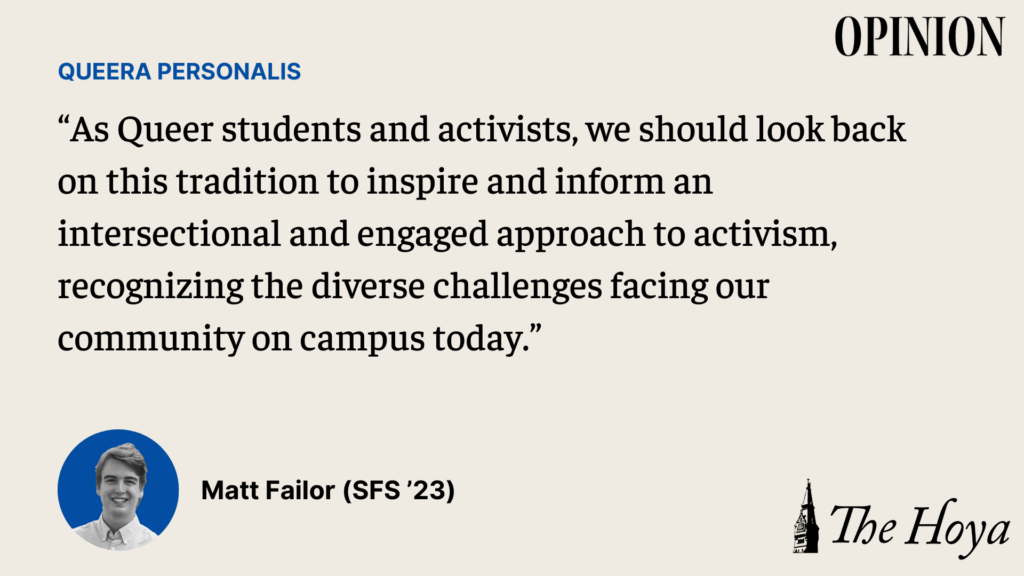Fourteen years ago this October, the president of Georgetown University, John J. DeGioia (CAS ’79, GRD ’95), addressed a packed ICC auditorium and publicly gave in: Georgetown would become the first Catholic college in the country to have a LGBTQ Resource Center, a space devoted to supporting Queer students and preventing anti-LGBTQ violence.
DeGioia’s announcement was the result of a monthslong campaign by Queer students and allies under the leadership of groups like GU Pride after a homophobic hate crime took place on campus. The campaign included rallies, petitions, protests and even a parody of Britney Spears’ “…Baby One More Time” that shamed Georgetown’s administration for its inaction. The ultimately successful campaign is only one example of Georgetown’s decadeslong history of Queer activism. As Queer students and activists, we should look back on this tradition to inspire and inform an intersectional and engaged approach to activism, recognizing the diverse challenges facing our community on campus today.
The challenges facing our campus go beyond our issues, and the progress we’ve made over the last forty years has privileged some groups over others, those groups being overwhelmingly white and cisgender. The challenge for Georgetown students, and especially white and cisgender students, is to keep up this activist spirit and show up for other communities.
The effort to establish the LGBTQ Center, known as the Out For Change campaign, was itself a continuation of a fight that started decades before. In 1980, two newly founded student organizations – Gay People of Georgetown University and Gay Rights Coalition of Georgetown University Law Center – sought to represent the Queer community on campus but faced adversity from the university after then-president Fr. Timothy S. Healy, S.J., personally denied the groups recognition and access to university benefits, setting off a protracted legal battle.
Throughout this process, Georgetown played dirty, publicly shaming student activists while privately threatening them. Nevertheless, the students wouldn’t give in. It affirmed the clubs’ existence and owned their space despite massive public pressure. Eventually, after an almost-decadelong legal struggle that nearly went to the Supreme Court, the courts sided with students, Georgetown conceded, and Queer-affiliated student groups were allowed to exist at Georgetown, whether the administration liked it or not.
The legacy of activists from this era inspired the Out For Change campaign. Students knew the university was not doing enough for its students and they weren’t afraid to make their voices heard. Their activism and eventual success directly led to the LGBTQ Resource Center, where many Queer students have gone to be heard and accepted.
These students include me. Like many Queer students, my first year of college was the first time I was able to own and fully accept my Queer identity, and it was spaces like the center and GU Pride that made stepping into my identity possible. For other students, the center was a place to work and congregate, a source of support in times of need or a necessary ally in battles against Georgetown’s often-dismissive administration. These benefits come directly from the action of the generations of Queer students before us.
Our community couldn’t be silenced in the 1980s during the fight to establish Queer student groups, in the 2000s during the fight to create the LGBTQ Resource Center or anywhere in between. We have always been here, always been Queer and always been willing to fight for our space. It’s easy to ignore the work of the giants who came before us, as many in our community feel safe and accepted. Yet our fight has just begun.
Just because we have a LGBTQ Center doesn’t mean the center will be fully funded and staffed. Just because student organizations exist doesn’t mean they’re effective and dedicated advocates for the whole community. Just because some people feel accepted at Georgetown doesn’t mean we can assume that’s a universal experience.
Queer students of color as well as trans and nonbinary students face unique and intersectional challenges at Georgetown that won’t go away without dedicated activism driven by current students. Additionally, campus activism doesn’t begin and end with Queer issues, even for Queer students. This means Queer students need to show up for other marginalized groups.
Don’t rest on our laurels. Queer students have pulled this university forward on our issues over the last 40 years, and, indeed, we have made incredible progress. Yet, our work remains unfinished. Learn from our elders — stand up and don’t shut up until every member of our campus community feels safe, affirmed and loved.
Matthew Failor is a Junior in the School of Foreign Service. Queera Personalis is published every other week.














